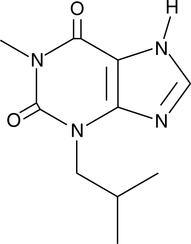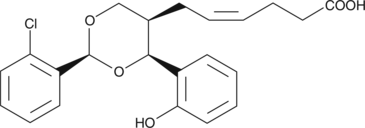Cayman
Showing 24451–24600 of 45550 results
-
IBMX is a widely-used non-specific inhibitor of cyclic AMP and cyclic GMP phosphodiesterases (PDEs) (IC50 = 19, 50, 18, 13, 32, 7, and 50 μM for PDE1, PDE2, PDE3, PDE4, PDE5, PDE7, and PDE11, respectively). PDE8A, PDE8B, and PDE9 are insensitive to IBMX.{17520} By inhibiting PDEs, IBMX increases cellular cAMP and cGMP levels, activating cyclic-nucleotide-regulated protein kinases. Methylxanthines, including IBMX, caffeine, and theophylline, bind adenosine receptors, typically antagonizing the suppressive effects of natural agonists.{17521}
Brand:CaymanSKU:-IBMX is a widely-used non-specific inhibitor of cyclic AMP and cyclic GMP phosphodiesterases (PDEs) (IC50 = 19, 50, 18, 13, 32, 7, and 50 μM for PDE1, PDE2, PDE3, PDE4, PDE5, PDE7, and PDE11, respectively). PDE8A, PDE8B, and PDE9 are insensitive to IBMX.{17520} By inhibiting PDEs, IBMX increases cellular cAMP and cGMP levels, activating cyclic-nucleotide-regulated protein kinases. Methylxanthines, including IBMX, caffeine, and theophylline, bind adenosine receptors, typically antagonizing the suppressive effects of natural agonists.{17521}
Brand:CaymanSKU:-IBMX is a widely-used non-specific inhibitor of cyclic AMP and cyclic GMP phosphodiesterases (PDEs) (IC50 = 19, 50, 18, 13, 32, 7, and 50 μM for PDE1, PDE2, PDE3, PDE4, PDE5, PDE7, and PDE11, respectively). PDE8A, PDE8B, and PDE9 are insensitive to IBMX.{17520} By inhibiting PDEs, IBMX increases cellular cAMP and cGMP levels, activating cyclic-nucleotide-regulated protein kinases. Methylxanthines, including IBMX, caffeine, and theophylline, bind adenosine receptors, typically antagonizing the suppressive effects of natural agonists.{17521}
Brand:CaymanSKU:-Ibotenic acid is a neuroexcitatory amino acid originally isolated from Amanita species that functions as a NMDA and metabotropic glutamate receptor agonist.{23073} As a neurotoxin, ibotenic acid is often used to induce brain lesions in animals that model cognitive dysfunctions resulting from neurodegenerative diseases, traumatic brain injury, and stroke.{23074}
Brand:CaymanSKU:-Ibotenic acid is a neuroexcitatory amino acid originally isolated from Amanita species that functions as a NMDA and metabotropic glutamate receptor agonist.{23073} As a neurotoxin, ibotenic acid is often used to induce brain lesions in animals that model cognitive dysfunctions resulting from neurodegenerative diseases, traumatic brain injury, and stroke.{23074}
Brand:CaymanSKU:-Ibotenic acid is a neuroexcitatory amino acid originally isolated from Amanita species that functions as a NMDA and metabotropic glutamate receptor agonist.{23073} As a neurotoxin, ibotenic acid is often used to induce brain lesions in animals that model cognitive dysfunctions resulting from neurodegenerative diseases, traumatic brain injury, and stroke.{23074}
Brand:CaymanSKU:-Bruton’s tyrosine kinase (BTK) is a member of the BTK/Tec family of protein tyrosine kinases involved in signal transduction pathways regulating proliferation, survival, migration, and tissue homing of B-cells.{24859} Ibrutinib is an irreversible inhibitor of BTK (IC50 = 0.5 nM) that selectively blocks B cell activation, promoting apoptosis and preventing homing to the protective tumor microenvironment, at concentrations that do not affect T cell receptor signaling (1,000-fold more potent).{27081,27080} It has been reported to inhibit autophosphorylation of BTK (IC50 = 11 nM), phosphorylation of PLCγ (IC50 = 29 nM), a substrate of BTK, and phosphorylation of ERK (IC50 = 13 nM), a further downstream kinase.{27081} Its use has been examined clinically for the treatment of diseases associated with B cell antigen receptor signaling, including mantle cell lymphoma, chronic lymphocytic leukemia, and non-Hodgkin lymphoma.{24859,27081,24780}
Brand:CaymanSKU:-Bruton’s tyrosine kinase (BTK) is a member of the BTK/Tec family of protein tyrosine kinases involved in signal transduction pathways regulating proliferation, survival, migration, and tissue homing of B-cells.{24859} Ibrutinib is an irreversible inhibitor of BTK (IC50 = 0.5 nM) that selectively blocks B cell activation, promoting apoptosis and preventing homing to the protective tumor microenvironment, at concentrations that do not affect T cell receptor signaling (1,000-fold more potent).{27081,27080} It has been reported to inhibit autophosphorylation of BTK (IC50 = 11 nM), phosphorylation of PLCγ (IC50 = 29 nM), a substrate of BTK, and phosphorylation of ERK (IC50 = 13 nM), a further downstream kinase.{27081} Its use has been examined clinically for the treatment of diseases associated with B cell antigen receptor signaling, including mantle cell lymphoma, chronic lymphocytic leukemia, and non-Hodgkin lymphoma.{24859,27081,24780}
Brand:CaymanSKU:-Bruton’s tyrosine kinase (BTK) is a member of the BTK/Tec family of protein tyrosine kinases involved in signal transduction pathways regulating proliferation, survival, migration, and tissue homing of B-cells.{24859} Ibrutinib is an irreversible inhibitor of BTK (IC50 = 0.5 nM) that selectively blocks B cell activation, promoting apoptosis and preventing homing to the protective tumor microenvironment, at concentrations that do not affect T cell receptor signaling (1,000-fold more potent).{27081,27080} It has been reported to inhibit autophosphorylation of BTK (IC50 = 11 nM), phosphorylation of PLCγ (IC50 = 29 nM), a substrate of BTK, and phosphorylation of ERK (IC50 = 13 nM), a further downstream kinase.{27081} Its use has been examined clinically for the treatment of diseases associated with B cell antigen receptor signaling, including mantle cell lymphoma, chronic lymphocytic leukemia, and non-Hodgkin lymphoma.{24859,27081,24780}
Brand:CaymanSKU:-Bruton’s tyrosine kinase (BTK) is a member of the BTK/Tec family of protein tyrosine kinases involved in signal transduction pathways regulating proliferation, survival, migration, and tissue homing of B-cells.{24859} Ibrutinib is an irreversible inhibitor of BTK (IC50 = 0.5 nM) that selectively blocks B cell activation, promoting apoptosis and preventing homing to the protective tumor microenvironment, at concentrations that do not affect T cell receptor signaling (1,000-fold more potent).{27081,27080} It has been reported to inhibit autophosphorylation of BTK (IC50 = 11 nM), phosphorylation of PLCγ (IC50 = 29 nM), a substrate of BTK, and phosphorylation of ERK (IC50 = 13 nM), a further downstream kinase.{27081} Its use has been examined clinically for the treatment of diseases associated with B cell antigen receptor signaling, including mantle cell lymphoma, chronic lymphocytic leukemia, and non-Hodgkin lymphoma.{24859,27081,24780}
Brand:CaymanSKU:-Ibrutinib-d5 is intended for use as an internal standard for the quantification of ibrutinib (Item No. 16274) by GC- or LC-MS. Ibrutinib is an irreversible inhibitor of Bruton’s tyrosine kinase (BTK; IC50 = 0.5 nM) that selectively blocks B cell activation, promoting apoptosis and preventing homing to the protective tumor microenvironment, at concentrations that do not affect T cell receptor signaling (1,000-fold more potent).{27081,27080} It has been reported to inhibit autophosphorylation of BTK (IC50 = 11 nM), phosphorylation of PLCγ (IC50 = 29 nM), a substrate of BTK, and phosphorylation of ERK (IC50 = 13 nM), a further downstream kinase.{27081} Formulations containing it have been examined clinically for the treatment of diseases associated with B cell antigen receptor signaling, including mantle cell lymphoma, chronic lymphocytic leukemia, and non-Hodgkin lymphoma.{24859,27081,24780}
Brand:CaymanSKU:22561 -Out of stock
Ibrutinib-d5 is intended for use as an internal standard for the quantification of ibrutinib (Item No. 16274) by GC- or LC-MS. Ibrutinib is an irreversible inhibitor of Bruton’s tyrosine kinase (BTK; IC50 = 0.5 nM) that selectively blocks B cell activation, promoting apoptosis and preventing homing to the protective tumor microenvironment, at concentrations that do not affect T cell receptor signaling (1,000-fold more potent).{27081,27080} It has been reported to inhibit autophosphorylation of BTK (IC50 = 11 nM), phosphorylation of PLCγ (IC50 = 29 nM), a substrate of BTK, and phosphorylation of ERK (IC50 = 13 nM), a further downstream kinase.{27081} Formulations containing it have been examined clinically for the treatment of diseases associated with B cell antigen receptor signaling, including mantle cell lymphoma, chronic lymphocytic leukemia, and non-Hodgkin lymphoma.{24859,27081,24780}
Brand:CaymanSKU:22561 -Out of stock
Ibrutinib-d5 is intended for use as an internal standard for the quantification of ibrutinib (Item No. 16274) by GC- or LC-MS. Ibrutinib is an irreversible inhibitor of Bruton’s tyrosine kinase (BTK; IC50 = 0.5 nM) that selectively blocks B cell activation, promoting apoptosis and preventing homing to the protective tumor microenvironment, at concentrations that do not affect T cell receptor signaling (1,000-fold more potent).{27081,27080} It has been reported to inhibit autophosphorylation of BTK (IC50 = 11 nM), phosphorylation of PLCγ (IC50 = 29 nM), a substrate of BTK, and phosphorylation of ERK (IC50 = 13 nM), a further downstream kinase.{27081} Formulations containing it have been examined clinically for the treatment of diseases associated with B cell antigen receptor signaling, including mantle cell lymphoma, chronic lymphocytic leukemia, and non-Hodgkin lymphoma.{24859,27081,24780}
Brand:CaymanSKU:22561 -Out of stock
IBTP is a lipophilic cation that is accumulated in mitochondria and forms stable thioether adducts in a thiol-specific manner.{32309} As a result, mitochondrial proteins that have changed thiol redox state following oxidative stress are selectively tagged with IBTP and can be separated by two-dimensional electrophoresis and isolated.{32309} IBTP-tagged proteins can also be evaluated by immunoblotting using an antibody directed against the triphenylphosphonium moiety of the IBTP molecule.{32311} IBTP has also been used as a mitochondria-targeted soft electrophile to inhibit mitochondrial oxidative phosphorylation.{32310}
Brand:CaymanSKU:-Available on backorder
IBTP is a lipophilic cation that is accumulated in mitochondria and forms stable thioether adducts in a thiol-specific manner.{32309} As a result, mitochondrial proteins that have changed thiol redox state following oxidative stress are selectively tagged with IBTP and can be separated by two-dimensional electrophoresis and isolated.{32309} IBTP-tagged proteins can also be evaluated by immunoblotting using an antibody directed against the triphenylphosphonium moiety of the IBTP molecule.{32311} IBTP has also been used as a mitochondria-targeted soft electrophile to inhibit mitochondrial oxidative phosphorylation.{32310}
Brand:CaymanSKU:-Available on backorder
Ibudilast is an inhibitor of phosphodiesterase 4 (PDE4; IC50s = 54, 65, 239, and 166 nM for PDE4A-D, respectively).{23596} It is selective for PDE4 over PDE1, PDE7A, PDE7B, and PDE9A (IC50s = ≥10,000 nM for all) but does inhibit PDE3A, PDE3B, and PDE5A (IC50s = 1,600, 2,700, and 3,510 nM, respectively). Ibudilast inhibits LPS-induced production of TNF-α and fMLP-induced production of leukotriene B4 (LTB4; Item No. 20110) in isolated human whole blood (IC50s = 6.2 and 2.5 μM, respectively). It inhibits bronchospasm by 34% in a guinea pig model of leukotriene-mediated allergic bronchospasm when administered intravenously at a dose of 5 mg/kg.{47641} Ibudilast prevents increases in TNF-α, IL-1β, and IL-6 expression in the striatum in a mouse model of MPTP-induced Parkinson’s disease.{47642} It also increases striatal expression of glial cell-derived neurotrophic factor (GDNF) in MPTP-treated and -untreated mice when administered at doses of 40 and 50 mg/kg, respectively, twice per day.
Brand:CaymanSKU:-Ibudilast is an inhibitor of phosphodiesterase 4 (PDE4; IC50s = 54, 65, 239, and 166 nM for PDE4A-D, respectively).{23596} It is selective for PDE4 over PDE1, PDE7A, PDE7B, and PDE9A (IC50s = ≥10,000 nM for all) but does inhibit PDE3A, PDE3B, and PDE5A (IC50s = 1,600, 2,700, and 3,510 nM, respectively). Ibudilast inhibits LPS-induced production of TNF-α and fMLP-induced production of leukotriene B4 (LTB4; Item No. 20110) in isolated human whole blood (IC50s = 6.2 and 2.5 μM, respectively). It inhibits bronchospasm by 34% in a guinea pig model of leukotriene-mediated allergic bronchospasm when administered intravenously at a dose of 5 mg/kg.{47641} Ibudilast prevents increases in TNF-α, IL-1β, and IL-6 expression in the striatum in a mouse model of MPTP-induced Parkinson’s disease.{47642} It also increases striatal expression of glial cell-derived neurotrophic factor (GDNF) in MPTP-treated and -untreated mice when administered at doses of 40 and 50 mg/kg, respectively, twice per day.
Brand:CaymanSKU:-Ibudilast is an inhibitor of phosphodiesterase 4 (PDE4; IC50s = 54, 65, 239, and 166 nM for PDE4A-D, respectively).{23596} It is selective for PDE4 over PDE1, PDE7A, PDE7B, and PDE9A (IC50s = ≥10,000 nM for all) but does inhibit PDE3A, PDE3B, and PDE5A (IC50s = 1,600, 2,700, and 3,510 nM, respectively). Ibudilast inhibits LPS-induced production of TNF-α and fMLP-induced production of leukotriene B4 (LTB4; Item No. 20110) in isolated human whole blood (IC50s = 6.2 and 2.5 μM, respectively). It inhibits bronchospasm by 34% in a guinea pig model of leukotriene-mediated allergic bronchospasm when administered intravenously at a dose of 5 mg/kg.{47641} Ibudilast prevents increases in TNF-α, IL-1β, and IL-6 expression in the striatum in a mouse model of MPTP-induced Parkinson’s disease.{47642} It also increases striatal expression of glial cell-derived neurotrophic factor (GDNF) in MPTP-treated and -untreated mice when administered at doses of 40 and 50 mg/kg, respectively, twice per day.
Brand:CaymanSKU:-Ibudilast is an inhibitor of phosphodiesterase 4 (PDE4; IC50s = 54, 65, 239, and 166 nM for PDE4A-D, respectively).{23596} It is selective for PDE4 over PDE1, PDE7A, PDE7B, and PDE9A (IC50s = ≥10,000 nM for all) but does inhibit PDE3A, PDE3B, and PDE5A (IC50s = 1,600, 2,700, and 3,510 nM, respectively). Ibudilast inhibits LPS-induced production of TNF-α and fMLP-induced production of leukotriene B4 (LTB4; Item No. 20110) in isolated human whole blood (IC50s = 6.2 and 2.5 μM, respectively). It inhibits bronchospasm by 34% in a guinea pig model of leukotriene-mediated allergic bronchospasm when administered intravenously at a dose of 5 mg/kg.{47641} Ibudilast prevents increases in TNF-α, IL-1β, and IL-6 expression in the striatum in a mouse model of MPTP-induced Parkinson’s disease.{47642} It also increases striatal expression of glial cell-derived neurotrophic factor (GDNF) in MPTP-treated and -untreated mice when administered at doses of 40 and 50 mg/kg, respectively, twice per day.
Brand:CaymanSKU:-Ibufenac is an analog of the NSAID ibuprofen (Item No. 70280) that inhibits COX-1 and -2 activity with IC50 values of 17.4 and 13.1 µM, respectively.{29030}
Brand:CaymanSKU:-Available on backorder
Ibufenac is an analog of the NSAID ibuprofen (Item No. 70280) that inhibits COX-1 and -2 activity with IC50 values of 17.4 and 13.1 µM, respectively.{29030}
Brand:CaymanSKU:-Available on backorder
Ibufenac is an analog of the NSAID ibuprofen (Item No. 70280) that inhibits COX-1 and -2 activity with IC50 values of 17.4 and 13.1 µM, respectively.{29030}
Brand:CaymanSKU:-Available on backorder
Ibufenac is an analog of the NSAID ibuprofen (Item No. 70280) that inhibits COX-1 and -2 activity with IC50 values of 17.4 and 13.1 µM, respectively.{29030}
Brand:CaymanSKU:-Available on backorder
Ibuprofen carboxylic acid is a major metabolite of ibuprofen (Item Nos. 70280 | 16793 | 16794).{43622} It prevents fructose-, cyanate-, and prednisolone-induced inactivation of catalase and fructose- and cyanate-induced inactivation of fumarase when used at a concentration of 2 mM and penetrates into the lens of isolated bovine eyes.{43623} Ibuprofen carboxylic acid has been found in bank filtrate and surface water, as well as influent and effluent wastewater, and is considered a micropollutant.{43624}
Brand:CaymanSKU:26594 - 1 mgAvailable on backorder
Ibuprofen carboxylic acid is a major metabolite of ibuprofen (Item Nos. 70280 | 16793 | 16794).{43622} It prevents fructose-, cyanate-, and prednisolone-induced inactivation of catalase and fructose- and cyanate-induced inactivation of fumarase when used at a concentration of 2 mM and penetrates into the lens of isolated bovine eyes.{43623} Ibuprofen carboxylic acid has been found in bank filtrate and surface water, as well as influent and effluent wastewater, and is considered a micropollutant.{43624}
Brand:CaymanSKU:26594 - 500 µgAvailable on backorder
Ghrelin is an endogenous ligand for the growth hormone (GH) secretagogue receptor (GHSR).{7811} Ibutamoren is an orally-active, non-peptidic agonist of GHSR (Kd = 0.4 nM) and, as a result, is a GH secretagogue.{3021,3308} It elevates GH in dogs after oral doses as low as 0.125 mg/kg, without significantly changing plasma levels of aldosterone, luteinizing hormone, thyroxine, or prolactin.{30759}
Brand:CaymanSKU:-Available on backorder
Ghrelin is an endogenous ligand for the growth hormone (GH) secretagogue receptor (GHSR).{7811} Ibutamoren is an orally-active, non-peptidic agonist of GHSR (Kd = 0.4 nM) and, as a result, is a GH secretagogue.{3021,3308} It elevates GH in dogs after oral doses as low as 0.125 mg/kg, without significantly changing plasma levels of aldosterone, luteinizing hormone, thyroxine, or prolactin.{30759}
Brand:CaymanSKU:-Available on backorder
Ghrelin is an endogenous ligand for the growth hormone (GH) secretagogue receptor (GHSR).{7811} Ibutamoren is an orally-active, non-peptidic agonist of GHSR (Kd = 0.4 nM) and, as a result, is a GH secretagogue.{3021,3308} It elevates GH in dogs after oral doses as low as 0.125 mg/kg, without significantly changing plasma levels of aldosterone, luteinizing hormone, thyroxine, or prolactin.{30759}
Brand:CaymanSKU:-Available on backorder
Ghrelin is an endogenous ligand for the growth hormone (GH) secretagogue receptor (GHSR).{7811} Ibutamoren is an orally-active, non-peptidic agonist of GHSR (Kd = 0.4 nM) and, as a result, is a GH secretagogue.{3021,3308} It elevates GH in dogs after oral doses as low as 0.125 mg/kg, without significantly changing plasma levels of aldosterone, luteinizing hormone, thyroxine, or prolactin.{30759}
Brand:CaymanSKU:-Available on backorder
The phosphatidylinositol 3-kinase (PI3K) signaling pathway has central roles in cell growth, development, and survival.{13740,17822} IC-87114 is a cell-permeable selective inhibitor of the PI3K catalytic subunit p110δ (IC50 = 0.5 μM).{24748} It less effectively inhibits p110γ and p110β (IC50 = 29 and 75 μM, respectively) and has no significant effect on p110α and several other kinases.{24748,24749} This product is used to elucidate the role of p110δ in cells, including neutrophils, natural killer cells, and other types of leukocytes.{24748,24749,24750,21846,24751} It has also been used in mice.{24752}
Brand:CaymanSKU:11589 - 1 mgAvailable on backorder
The phosphatidylinositol 3-kinase (PI3K) signaling pathway has central roles in cell growth, development, and survival.{13740,17822} IC-87114 is a cell-permeable selective inhibitor of the PI3K catalytic subunit p110δ (IC50 = 0.5 μM).{24748} It less effectively inhibits p110γ and p110β (IC50 = 29 and 75 μM, respectively) and has no significant effect on p110α and several other kinases.{24748,24749} This product is used to elucidate the role of p110δ in cells, including neutrophils, natural killer cells, and other types of leukocytes.{24748,24749,24750,21846,24751} It has also been used in mice.{24752}
Brand:CaymanSKU:11589 - 10 mgAvailable on backorder
The phosphatidylinositol 3-kinase (PI3K) signaling pathway has central roles in cell growth, development, and survival.{13740,17822} IC-87114 is a cell-permeable selective inhibitor of the PI3K catalytic subunit p110δ (IC50 = 0.5 μM).{24748} It less effectively inhibits p110γ and p110β (IC50 = 29 and 75 μM, respectively) and has no significant effect on p110α and several other kinases.{24748,24749} This product is used to elucidate the role of p110δ in cells, including neutrophils, natural killer cells, and other types of leukocytes.{24748,24749,24750,21846,24751} It has also been used in mice.{24752}
Brand:CaymanSKU:11589 - 5 mgAvailable on backorder
The phosphatidylinositol 3-kinase (PI3K) signaling pathway has central roles in cell growth, development, and survival.{13740,17822} IC-87114 is a cell-permeable selective inhibitor of the PI3K catalytic subunit p110δ (IC50 = 0.5 μM).{24748} It less effectively inhibits p110γ and p110β (IC50 = 29 and 75 μM, respectively) and has no significant effect on p110α and several other kinases.{24748,24749} This product is used to elucidate the role of p110δ in cells, including neutrophils, natural killer cells, and other types of leukocytes.{24748,24749,24750,21846,24751} It has also been used in mice.{24752}
Brand:CaymanSKU:11589 - 50 mgAvailable on backorder
IC261 is a reversible, ATP-competitive inhibitor of casein kinase 1 (CK1) that inhibits CK1δ and CK1ɛ (IC50 = ~1 µM for both), as well as CK1α (IC50 = 16 µM).{28923} It is at least 100-fold less effective against PKA, p34cdc2, and p55fyn.{28923} IC 261, at 1 µM, inhibits cytokinesis in primary mouse embryo fibroblasts.{28921} IC261 is used to elucidate the role of CK1 in cells and in whole organisms.{28925,28924,28922}
Brand:CaymanSKU:-Out of stock
IC261 is a reversible, ATP-competitive inhibitor of casein kinase 1 (CK1) that inhibits CK1δ and CK1ɛ (IC50 = ~1 µM for both), as well as CK1α (IC50 = 16 µM).{28923} It is at least 100-fold less effective against PKA, p34cdc2, and p55fyn.{28923} IC 261, at 1 µM, inhibits cytokinesis in primary mouse embryo fibroblasts.{28921} IC261 is used to elucidate the role of CK1 in cells and in whole organisms.{28925,28924,28922}
Brand:CaymanSKU:-Out of stock
IC261 is a reversible, ATP-competitive inhibitor of casein kinase 1 (CK1) that inhibits CK1δ and CK1ɛ (IC50 = ~1 µM for both), as well as CK1α (IC50 = 16 µM).{28923} It is at least 100-fold less effective against PKA, p34cdc2, and p55fyn.{28923} IC 261, at 1 µM, inhibits cytokinesis in primary mouse embryo fibroblasts.{28921} IC261 is used to elucidate the role of CK1 in cells and in whole organisms.{28925,28924,28922}
Brand:CaymanSKU:-Out of stock
IC261 is a reversible, ATP-competitive inhibitor of casein kinase 1 (CK1) that inhibits CK1δ and CK1ɛ (IC50 = ~1 µM for both), as well as CK1α (IC50 = 16 µM).{28923} It is at least 100-fold less effective against PKA, p34cdc2, and p55fyn.{28923} IC 261, at 1 µM, inhibits cytokinesis in primary mouse embryo fibroblasts.{28921} IC261 is used to elucidate the role of CK1 in cells and in whole organisms.{28925,28924,28922}
Brand:CaymanSKU:-Out of stock
ICA 069673 is a heteromeric Kv7 channel activator.{39323,39324} It is selective for Kv7.2/7.3 over Kv7.3/7.5 (EC50s = 0.69 and 14.3 μM, respectively) and also activates Kv7.4, Kv7.5, and heteromeric Kv7.4/7.5 channels in a dose-dependent manner.{39324} ICA 069673 has no activity against hERG, Nav1.5, and Kv7.1 cardiac ion channels (IC50s = >30 μM).{39323} Oral administration of ICA 069673 increases latency to first tonic-clonic seizure in the rat maximal electroshock and pentylentetrazol-induced seizure models (ED50s = 1.5 and <1 mg/kg, respectively).{39323} Formulations containing ICA 069673 are under clinical investigation for the treatment of epilepsy.
Brand:CaymanSKU:22995 - 10 mgAvailable on backorder
ICA 069673 is a heteromeric Kv7 channel activator.{39323,39324} It is selective for Kv7.2/7.3 over Kv7.3/7.5 (EC50s = 0.69 and 14.3 μM, respectively) and also activates Kv7.4, Kv7.5, and heteromeric Kv7.4/7.5 channels in a dose-dependent manner.{39324} ICA 069673 has no activity against hERG, Nav1.5, and Kv7.1 cardiac ion channels (IC50s = >30 μM).{39323} Oral administration of ICA 069673 increases latency to first tonic-clonic seizure in the rat maximal electroshock and pentylentetrazol-induced seizure models (ED50s = 1.5 and <1 mg/kg, respectively).{39323} Formulations containing ICA 069673 are under clinical investigation for the treatment of epilepsy.
Brand:CaymanSKU:22995 - 25 mgAvailable on backorder
ICA 069673 is a heteromeric Kv7 channel activator.{39323,39324} It is selective for Kv7.2/7.3 over Kv7.3/7.5 (EC50s = 0.69 and 14.3 μM, respectively) and also activates Kv7.4, Kv7.5, and heteromeric Kv7.4/7.5 channels in a dose-dependent manner.{39324} ICA 069673 has no activity against hERG, Nav1.5, and Kv7.1 cardiac ion channels (IC50s = >30 μM).{39323} Oral administration of ICA 069673 increases latency to first tonic-clonic seizure in the rat maximal electroshock and pentylentetrazol-induced seizure models (ED50s = 1.5 and <1 mg/kg, respectively).{39323} Formulations containing ICA 069673 are under clinical investigation for the treatment of epilepsy.
Brand:CaymanSKU:22995 - 5 mgAvailable on backorder
ICA 069673 is a heteromeric Kv7 channel activator.{39323,39324} It is selective for Kv7.2/7.3 over Kv7.3/7.5 (EC50s = 0.69 and 14.3 μM, respectively) and also activates Kv7.4, Kv7.5, and heteromeric Kv7.4/7.5 channels in a dose-dependent manner.{39324} ICA 069673 has no activity against hERG, Nav1.5, and Kv7.1 cardiac ion channels (IC50s = >30 μM).{39323} Oral administration of ICA 069673 increases latency to first tonic-clonic seizure in the rat maximal electroshock and pentylentetrazol-induced seizure models (ED50s = 1.5 and <1 mg/kg, respectively).{39323} Formulations containing ICA 069673 are under clinical investigation for the treatment of epilepsy.
Brand:CaymanSKU:22995 - 50 mgAvailable on backorder
ICA 121431 is a voltage-gated sodium channel (Nav) blocker that selectively blocks Nav1.1 and Nav1.3 over Nav1.4, and Nav1.5-1.8 channels (IC50s = 10,000 nM, respectively).{36656} It induces a concentration-dependent hyperpolarizing shift in voltage dependence of inactivation of Nav1.3 channels at a concentration 1 μM but has no effect on resting channels. Substitution of the Nav1.3 domain IV voltage-sensor domain (VSD4) with the Nav1.5 VSD4 reduces ICA 121431 potency by approximately 500-fold.
Brand:CaymanSKU:24669 - 1 mgAvailable on backorder
ICA 121431 is a voltage-gated sodium channel (Nav) blocker that selectively blocks Nav1.1 and Nav1.3 over Nav1.4, and Nav1.5-1.8 channels (IC50s = 10,000 nM, respectively).{36656} It induces a concentration-dependent hyperpolarizing shift in voltage dependence of inactivation of Nav1.3 channels at a concentration 1 μM but has no effect on resting channels. Substitution of the Nav1.3 domain IV voltage-sensor domain (VSD4) with the Nav1.5 VSD4 reduces ICA 121431 potency by approximately 500-fold.
Brand:CaymanSKU:24669 - 10 mgAvailable on backorder
ICA 121431 is a voltage-gated sodium channel (Nav) blocker that selectively blocks Nav1.1 and Nav1.3 over Nav1.4, and Nav1.5-1.8 channels (IC50s = 10,000 nM, respectively).{36656} It induces a concentration-dependent hyperpolarizing shift in voltage dependence of inactivation of Nav1.3 channels at a concentration 1 μM but has no effect on resting channels. Substitution of the Nav1.3 domain IV voltage-sensor domain (VSD4) with the Nav1.5 VSD4 reduces ICA 121431 potency by approximately 500-fold.
Brand:CaymanSKU:24669 - 25 mgAvailable on backorder
ICA 121431 is a voltage-gated sodium channel (Nav) blocker that selectively blocks Nav1.1 and Nav1.3 over Nav1.4, and Nav1.5-1.8 channels (IC50s = 10,000 nM, respectively).{36656} It induces a concentration-dependent hyperpolarizing shift in voltage dependence of inactivation of Nav1.3 channels at a concentration 1 μM but has no effect on resting channels. Substitution of the Nav1.3 domain IV voltage-sensor domain (VSD4) with the Nav1.5 VSD4 reduces ICA 121431 potency by approximately 500-fold.
Brand:CaymanSKU:24669 - 5 mgAvailable on backorder
The cyclic nucleotide second messenger guanosine 3’5’-cyclic monophosphate (cGMP) is an important mediator of signal transduction and hence a wide range of cellular processes. It is generated by soluble- and particulate-type guanylyl cyclase and degraded via members of the phosphodiesterase (PDE) protein family. Icariin, the active component of the Chinese medicinal plant E. brevicornum, is an inhibitor of human recombinant PDE5 with an IC50 value of 5.9 µM.{17617} It is a prenylated flavonol that has been used to treat erectile dysfunction and has been shown to have anti-cancer and antioxidant activity.{17873} At a concentration of 1 x 107 mol/L, icariin induces differentiation of cardiomyocytes and upregulates the expression of cardiac genes.{17874} At 20 µg/ml, icariin increases the proliferation and differentiation of cultured human osteoblasts, which appears to be mediated in part by upregulating bone morphogenetic protein 2 mRNA.{17875}
Brand:CaymanSKU:-The cyclic nucleotide second messenger guanosine 3’5’-cyclic monophosphate (cGMP) is an important mediator of signal transduction and hence a wide range of cellular processes. It is generated by soluble- and particulate-type guanylyl cyclase and degraded via members of the phosphodiesterase (PDE) protein family. Icariin, the active component of the Chinese medicinal plant E. brevicornum, is an inhibitor of human recombinant PDE5 with an IC50 value of 5.9 µM.{17617} It is a prenylated flavonol that has been used to treat erectile dysfunction and has been shown to have anti-cancer and antioxidant activity.{17873} At a concentration of 1 x 107 mol/L, icariin induces differentiation of cardiomyocytes and upregulates the expression of cardiac genes.{17874} At 20 µg/ml, icariin increases the proliferation and differentiation of cultured human osteoblasts, which appears to be mediated in part by upregulating bone morphogenetic protein 2 mRNA.{17875}
Brand:CaymanSKU:-The cyclic nucleotide second messenger guanosine 3’5’-cyclic monophosphate (cGMP) is an important mediator of signal transduction and hence a wide range of cellular processes. It is generated by soluble- and particulate-type guanylyl cyclase and degraded via members of the phosphodiesterase (PDE) protein family. Icariin, the active component of the Chinese medicinal plant E. brevicornum, is an inhibitor of human recombinant PDE5 with an IC50 value of 5.9 µM.{17617} It is a prenylated flavonol that has been used to treat erectile dysfunction and has been shown to have anti-cancer and antioxidant activity.{17873} At a concentration of 1 x 107 mol/L, icariin induces differentiation of cardiomyocytes and upregulates the expression of cardiac genes.{17874} At 20 µg/ml, icariin increases the proliferation and differentiation of cultured human osteoblasts, which appears to be mediated in part by upregulating bone morphogenetic protein 2 mRNA.{17875}
Brand:CaymanSKU:-The cyclic nucleotide second messenger guanosine 3’5’-cyclic monophosphate (cGMP) is an important mediator of signal transduction and hence a wide range of cellular processes. It is generated by soluble- and particulate-type guanylyl cyclase and degraded via members of the phosphodiesterase (PDE) protein family. Icariin, the active component of the Chinese medicinal plant E. brevicornum, is an inhibitor of human recombinant PDE5 with an IC50 value of 5.9 µM.{17617} It is a prenylated flavonol that has been used to treat erectile dysfunction and has been shown to have anti-cancer and antioxidant activity.{17873} At a concentration of 1 x 107 mol/L, icariin induces differentiation of cardiomyocytes and upregulates the expression of cardiac genes.{17874} At 20 µg/ml, icariin increases the proliferation and differentiation of cultured human osteoblasts, which appears to be mediated in part by upregulating bone morphogenetic protein 2 mRNA.{17875}
Brand:CaymanSKU:-Icaritin is a flavonoid first isolated from the Chinese herb H. epimedii that demonstrates anticancer activity against a variety of tumor cell lines.{31631} It has been shown to inhibit fatty acid synthase, reducing IGF-1-induced activation of STAT3 in several melanoma cell lines.{31631}
Brand:CaymanSKU:20236 -Available on backorder
Icaritin is a flavonoid first isolated from the Chinese herb H. epimedii that demonstrates anticancer activity against a variety of tumor cell lines.{31631} It has been shown to inhibit fatty acid synthase, reducing IGF-1-induced activation of STAT3 in several melanoma cell lines.{31631}
Brand:CaymanSKU:20236 -Available on backorder
Icaritin is a flavonoid first isolated from the Chinese herb H. epimedii that demonstrates anticancer activity against a variety of tumor cell lines.{31631} It has been shown to inhibit fatty acid synthase, reducing IGF-1-induced activation of STAT3 in several melanoma cell lines.{31631}
Brand:CaymanSKU:20236 -Available on backorder
Icatibant is a synthetic peptide antagonist of the bradykinin B2 receptor with IC50 and Ki values of 1.07 and 0.798 nM, respectively, in guinea pig ileal cell membranes.{40794} It inhibits bradykinin-induced contractions in isolated guinea pig ileum and pulmonary arteries as well as in rat uterus (IC50s = 11, 5.4, and 4.9 nM, respectively). In vivo, icatibant inhibits bronchoconstriction induced by bradykinin (Item No. 15539) in a guinea pig model (ID50s = 13.4 and 31.8 pmol/kg, i.v., for pulmonary resistance and dynamic lung compliance, respectively).{40794} Icatibant (30 µg, i.v.) also reduces vascular permeability in the footpad and intestine in a mouse model of hereditary angioedema.{40793} Formulations containing icatibant have been used for the treatment of hereditary angioedema.
Brand:CaymanSKU:24083 - 1 mgAvailable on backorder
Icatibant is a synthetic peptide antagonist of the bradykinin B2 receptor with IC50 and Ki values of 1.07 and 0.798 nM, respectively, in guinea pig ileal cell membranes.{40794} It inhibits bradykinin-induced contractions in isolated guinea pig ileum and pulmonary arteries as well as in rat uterus (IC50s = 11, 5.4, and 4.9 nM, respectively). In vivo, icatibant inhibits bronchoconstriction induced by bradykinin (Item No. 15539) in a guinea pig model (ID50s = 13.4 and 31.8 pmol/kg, i.v., for pulmonary resistance and dynamic lung compliance, respectively).{40794} Icatibant (30 µg, i.v.) also reduces vascular permeability in the footpad and intestine in a mouse model of hereditary angioedema.{40793} Formulations containing icatibant have been used for the treatment of hereditary angioedema.
Brand:CaymanSKU:24083 - 5 mgAvailable on backorder
Icatibant is a synthetic peptide antagonist of the bradykinin B2 receptor with IC50 and Ki values of 1.07 and 0.798 nM, respectively, in guinea pig ileal cell membranes.{40794} It inhibits bradykinin-induced contractions in isolated guinea pig ileum and pulmonary arteries as well as in rat uterus (IC50s = 11, 5.4, and 4.9 nM, respectively). In vivo, icatibant inhibits bronchoconstriction induced by bradykinin (Item No. 15539) in a guinea pig model (ID50s = 13.4 and 31.8 pmol/kg, i.v., for pulmonary resistance and dynamic lung compliance, respectively).{40794} Icatibant (30 µg, i.v.) also reduces vascular permeability in the footpad and intestine in a mouse model of hereditary angioedema.{40793} Formulations containing icatibant have been used for the treatment of hereditary angioedema.
Brand:CaymanSKU:24083 - 500 µgAvailable on backorder
ICG-001 is a small molecule inhibitor of β-catenin/cyclic AMP responsive element binding protein (CREB) binding protein (CBP)-mediated transcription (IC50 = 3 µM).{26952} By binding CBP, thus blocking interaction with β-catenin, it selectively induces apoptosis in transformed colon cells but not in normal cells and prevents the growth of colon carcinoma cells at 25 µM in vitro.{26952,26951} ICG-001 has been used to specifically disrupt the β-catenin pathway in studying epithelial-mesenchymal transition during pulmonary fibrosis.{26949,26953} Additionally, ICG-001 disruption of Wnt/β-catenin signaling has been studied in the context of regulating cancer stem cells.{26950}
Brand:CaymanSKU:-ICG-001 is a small molecule inhibitor of β-catenin/cyclic AMP responsive element binding protein (CREB) binding protein (CBP)-mediated transcription (IC50 = 3 µM).{26952} By binding CBP, thus blocking interaction with β-catenin, it selectively induces apoptosis in transformed colon cells but not in normal cells and prevents the growth of colon carcinoma cells at 25 µM in vitro.{26952,26951} ICG-001 has been used to specifically disrupt the β-catenin pathway in studying epithelial-mesenchymal transition during pulmonary fibrosis.{26949,26953} Additionally, ICG-001 disruption of Wnt/β-catenin signaling has been studied in the context of regulating cancer stem cells.{26950}
Brand:CaymanSKU:-ICG-001 is a small molecule inhibitor of β-catenin/cyclic AMP responsive element binding protein (CREB) binding protein (CBP)-mediated transcription (IC50 = 3 µM).{26952} By binding CBP, thus blocking interaction with β-catenin, it selectively induces apoptosis in transformed colon cells but not in normal cells and prevents the growth of colon carcinoma cells at 25 µM in vitro.{26952,26951} ICG-001 has been used to specifically disrupt the β-catenin pathway in studying epithelial-mesenchymal transition during pulmonary fibrosis.{26949,26953} Additionally, ICG-001 disruption of Wnt/β-catenin signaling has been studied in the context of regulating cancer stem cells.{26950}
Brand:CaymanSKU:-ICG-001 is a small molecule inhibitor of β-catenin/cyclic AMP responsive element binding protein (CREB) binding protein (CBP)-mediated transcription (IC50 = 3 µM).{26952} By binding CBP, thus blocking interaction with β-catenin, it selectively induces apoptosis in transformed colon cells but not in normal cells and prevents the growth of colon carcinoma cells at 25 µM in vitro.{26952,26951} ICG-001 has been used to specifically disrupt the β-catenin pathway in studying epithelial-mesenchymal transition during pulmonary fibrosis.{26949,26953} Additionally, ICG-001 disruption of Wnt/β-catenin signaling has been studied in the context of regulating cancer stem cells.{26950}
Brand:CaymanSKU:-ICI 118551 is a potent, selective antagonist of the β2-adrenergic receptor (Ki = 0.7 nM for the β2 receptor, compared with 49.5 and 611 nM for β1 and β3 receptors, respectively).{25395,25151} It is active in vivo and is often used to evaluate the actions of adrenergic receptor agonists.{25421,23875,25153}
Brand:CaymanSKU:-ICI 118551 is a potent, selective antagonist of the β2-adrenergic receptor (Ki = 0.7 nM for the β2 receptor, compared with 49.5 and 611 nM for β1 and β3 receptors, respectively).{25395,25151} It is active in vivo and is often used to evaluate the actions of adrenergic receptor agonists.{25421,23875,25153}
Brand:CaymanSKU:-ICI 192605 is a potent antagonist of the thromboxane A2 receptor (TP) that blocks contraction of isolated guinea pig trachea induced by U-46619 (Item No. 16450; Kd = 0.398 nM).{33438,33440} It is used to study the role of TP signaling in tissues and animals.{33441,33442,11146,17188}
Brand:CaymanSKU:10135 - 1 mgAvailable on backorder
ICI 192605 is a potent antagonist of the thromboxane A2 receptor (TP) that blocks contraction of isolated guinea pig trachea induced by U-46619 (Item No. 16450; Kd = 0.398 nM).{33438,33440} It is used to study the role of TP signaling in tissues and animals.{33441,33442,11146,17188}
Brand:CaymanSKU:10135 - 10 mgAvailable on backorder
ICI 192605 is a potent antagonist of the thromboxane A2 receptor (TP) that blocks contraction of isolated guinea pig trachea induced by U-46619 (Item No. 16450; Kd = 0.398 nM).{33438,33440} It is used to study the role of TP signaling in tissues and animals.{33441,33442,11146,17188}
Brand:CaymanSKU:10135 - 25 mgAvailable on backorder
ICI 192605 is a potent antagonist of the thromboxane A2 receptor (TP) that blocks contraction of isolated guinea pig trachea induced by U-46619 (Item No. 16450; Kd = 0.398 nM).{33438,33440} It is used to study the role of TP signaling in tissues and animals.{33441,33442,11146,17188}
Brand:CaymanSKU:10135 - 5 mgAvailable on backorder
Bombesin is a peptide, originally isolated from the skin of the European fire-bellied toad, with pressor and sympathoexcitatory activity. Its three receptors are distributed throughout the central and peripheral nervous system and are involved in gastric acid secretion, emotional response, temperature control, learning, and memory. Neuromedin B and gastrin-releasing peptide (GRP) are mammalian homologs of bombesin.{28635} ICI 216140 is a GRP/bombesin receptor 2 antagonist (IC50 = 2 nM in vitro).{28634} At 2 mg/kg, it can reduce bombesin-stimulated pancreatic amylase secretion in rats.{28634} At 1 mM, it has been shown to attenuate bombesin-stimulated increases in blood pressure in rats.{28636}
Brand:CaymanSKU:-Available on backorder
Bombesin is a peptide, originally isolated from the skin of the European fire-bellied toad, with pressor and sympathoexcitatory activity. Its three receptors are distributed throughout the central and peripheral nervous system and are involved in gastric acid secretion, emotional response, temperature control, learning, and memory. Neuromedin B and gastrin-releasing peptide (GRP) are mammalian homologs of bombesin.{28635} ICI 216140 is a GRP/bombesin receptor 2 antagonist (IC50 = 2 nM in vitro).{28634} At 2 mg/kg, it can reduce bombesin-stimulated pancreatic amylase secretion in rats.{28634} At 1 mM, it has been shown to attenuate bombesin-stimulated increases in blood pressure in rats.{28636}
Brand:CaymanSKU:-Available on backorder
Bombesin is a peptide, originally isolated from the skin of the European fire-bellied toad, with pressor and sympathoexcitatory activity. Its three receptors are distributed throughout the central and peripheral nervous system and are involved in gastric acid secretion, emotional response, temperature control, learning, and memory. Neuromedin B and gastrin-releasing peptide (GRP) are mammalian homologs of bombesin.{28635} ICI 216140 is a GRP/bombesin receptor 2 antagonist (IC50 = 2 nM in vitro).{28634} At 2 mg/kg, it can reduce bombesin-stimulated pancreatic amylase secretion in rats.{28634} At 1 mM, it has been shown to attenuate bombesin-stimulated increases in blood pressure in rats.{28636}
Brand:CaymanSKU:-Available on backorder
Nociceptive sensory peripheral neurons often express both heat sensitive (VR1) and cold-sensitive (CMR1 (rat); TRPM8 (human)) receptors that are part of the transient receptor potential (TRP) superfamily. Icilin (AG 3-5) is a synthetic CMR1/TRPM8 super agonist that is 2.5-fold more efficacious and nearly 200-fold more potent than the reference cold thermosensory agonist, l-menthol.{11806} Icilin induces sensations of intense cold when applied orally in humans, and induces ‘wet dog shakes’, a behavioral marker of cold sensation, when given to rats. Icilin should serve as the reference cold nociceptive agonist for TRP-type ion channels in the future.{11805}
Brand:CaymanSKU:10137 - 10 mgAvailable on backorder
Nociceptive sensory peripheral neurons often express both heat sensitive (VR1) and cold-sensitive (CMR1 (rat); TRPM8 (human)) receptors that are part of the transient receptor potential (TRP) superfamily. Icilin (AG 3-5) is a synthetic CMR1/TRPM8 super agonist that is 2.5-fold more efficacious and nearly 200-fold more potent than the reference cold thermosensory agonist, l-menthol.{11806} Icilin induces sensations of intense cold when applied orally in humans, and induces ‘wet dog shakes’, a behavioral marker of cold sensation, when given to rats. Icilin should serve as the reference cold nociceptive agonist for TRP-type ion channels in the future.{11805}
Brand:CaymanSKU:10137 - 100 mgAvailable on backorder
Nociceptive sensory peripheral neurons often express both heat sensitive (VR1) and cold-sensitive (CMR1 (rat); TRPM8 (human)) receptors that are part of the transient receptor potential (TRP) superfamily. Icilin (AG 3-5) is a synthetic CMR1/TRPM8 super agonist that is 2.5-fold more efficacious and nearly 200-fold more potent than the reference cold thermosensory agonist, l-menthol.{11806} Icilin induces sensations of intense cold when applied orally in humans, and induces ‘wet dog shakes’, a behavioral marker of cold sensation, when given to rats. Icilin should serve as the reference cold nociceptive agonist for TRP-type ion channels in the future.{11805}
Brand:CaymanSKU:10137 - 5 mgAvailable on backorder
Nociceptive sensory peripheral neurons often express both heat sensitive (VR1) and cold-sensitive (CMR1 (rat); TRPM8 (human)) receptors that are part of the transient receptor potential (TRP) superfamily. Icilin (AG 3-5) is a synthetic CMR1/TRPM8 super agonist that is 2.5-fold more efficacious and nearly 200-fold more potent than the reference cold thermosensory agonist, l-menthol.{11806} Icilin induces sensations of intense cold when applied orally in humans, and induces ‘wet dog shakes’, a behavioral marker of cold sensation, when given to rats. Icilin should serve as the reference cold nociceptive agonist for TRP-type ion channels in the future.{11805}
Brand:CaymanSKU:10137 - 50 mgAvailable on backorder
Icosabutate is a synthetic ω-3 polyunsaturated fatty acid derived from eicosapentaenoic alcohol and 2-bromo butyric acid. It was designed to resist β-oxidation and complex lipid incorporation and increase efficacy in fatty acid-responsive intracellular signaling systems.{30867,33833} In a clinical trial, oral administration of icosabutate (600 mg) significantly reduced triglyceride, very low-density lipoprotein cholesterol, and Apo c-III levels in patients with very high triglyceride levels.{30867,33833}
Brand:CaymanSKU:-Available on backorder
Icosabutate is a synthetic ω-3 polyunsaturated fatty acid derived from eicosapentaenoic alcohol and 2-bromo butyric acid. It was designed to resist β-oxidation and complex lipid incorporation and increase efficacy in fatty acid-responsive intracellular signaling systems.{30867,33833} In a clinical trial, oral administration of icosabutate (600 mg) significantly reduced triglyceride, very low-density lipoprotein cholesterol, and Apo c-III levels in patients with very high triglyceride levels.{30867,33833}
Brand:CaymanSKU:-Available on backorder
Icotinib is an inhibitor of EGFR (IC50 = 2 nM).{57218} It is selective for EGFR over Abl, Abl2, and c-Src tyrosine kinases at 1,000 nM. Icotinib inhibits EGFR-mediated tyrosine phosphorylation in A431 human epidermoid carcinoma cells with an IC50 value of 45 nM. It inhibits the growth of PC-9 and HCC827 non-small cell lung cancer (NSCLC) cells (IC50s = 50 = 8,800 nM), which do not.{57219} It also inhibits migration of HCC827 cells when used at a concentration of 100 nM and increases apoptosis by 43.7% at 10 nM. Icotinib reduces tumor growth in a variety of mouse xenograft models when administered at doses ranging from 50 to 120 mg/kg per day.
Brand:CaymanSKU:30093 - 1 mgAvailable on backorder
Icotinib is an inhibitor of EGFR (IC50 = 2 nM).{57218} It is selective for EGFR over Abl, Abl2, and c-Src tyrosine kinases at 1,000 nM. Icotinib inhibits EGFR-mediated tyrosine phosphorylation in A431 human epidermoid carcinoma cells with an IC50 value of 45 nM. It inhibits the growth of PC-9 and HCC827 non-small cell lung cancer (NSCLC) cells (IC50s = 50 = 8,800 nM), which do not.{57219} It also inhibits migration of HCC827 cells when used at a concentration of 100 nM and increases apoptosis by 43.7% at 10 nM. Icotinib reduces tumor growth in a variety of mouse xenograft models when administered at doses ranging from 50 to 120 mg/kg per day.
Brand:CaymanSKU:30093 - 10 mgAvailable on backorder
Icotinib is an inhibitor of EGFR (IC50 = 2 nM).{57218} It is selective for EGFR over Abl, Abl2, and c-Src tyrosine kinases at 1,000 nM. Icotinib inhibits EGFR-mediated tyrosine phosphorylation in A431 human epidermoid carcinoma cells with an IC50 value of 45 nM. It inhibits the growth of PC-9 and HCC827 non-small cell lung cancer (NSCLC) cells (IC50s = 50 = 8,800 nM), which do not.{57219} It also inhibits migration of HCC827 cells when used at a concentration of 100 nM and increases apoptosis by 43.7% at 10 nM. Icotinib reduces tumor growth in a variety of mouse xenograft models when administered at doses ranging from 50 to 120 mg/kg per day.
Brand:CaymanSKU:30093 - 25 mgAvailable on backorder
Icotinib is an inhibitor of EGFR (IC50 = 2 nM).{57218} It is selective for EGFR over Abl, Abl2, and c-Src tyrosine kinases at 1,000 nM. Icotinib inhibits EGFR-mediated tyrosine phosphorylation in A431 human epidermoid carcinoma cells with an IC50 value of 45 nM. It inhibits the growth of PC-9 and HCC827 non-small cell lung cancer (NSCLC) cells (IC50s = 50 = 8,800 nM), which do not.{57219} It also inhibits migration of HCC827 cells when used at a concentration of 100 nM and increases apoptosis by 43.7% at 10 nM. Icotinib reduces tumor growth in a variety of mouse xenograft models when administered at doses ranging from 50 to 120 mg/kg per day.
Brand:CaymanSKU:30093 - 5 mgAvailable on backorder
iCRT14 is a potent inhibitor of β-catenin-responsive transcription (CRT) that inhibits Wnt signaling in a reporter assay in vitro (IC50 = 40.3 nM).{39368} It inhibits the interaction between β-catenin and T cell factor 4 (Tcf4) in quantitative reporter assays of β-catenin/Tcf4 binding (Ki = 53.51 μM).{39369} It inhibits Notch, hedgehog (Hh), and JAK/STAT signaling in reporter assays with IC50 values of 69.2, 194, and 70 nM, respectively. iCRT14 (50 mg/kg, i.p.) reduces the number of proliferating cells and leads to a decrease of approximately 50% in the initial tumor growth rate in mouse xenograft models of colon carcinoma. iCRT14 also inhibits proliferation of leukemia cell lines and suppresses ATP-driven migration of the MCF-7 and MDA-MB-231 breast cancer cell lines.{39370,39371}
Brand:CaymanSKU:22132 -Out of stock
iCRT14 is a potent inhibitor of β-catenin-responsive transcription (CRT) that inhibits Wnt signaling in a reporter assay in vitro (IC50 = 40.3 nM).{39368} It inhibits the interaction between β-catenin and T cell factor 4 (Tcf4) in quantitative reporter assays of β-catenin/Tcf4 binding (Ki = 53.51 μM).{39369} It inhibits Notch, hedgehog (Hh), and JAK/STAT signaling in reporter assays with IC50 values of 69.2, 194, and 70 nM, respectively. iCRT14 (50 mg/kg, i.p.) reduces the number of proliferating cells and leads to a decrease of approximately 50% in the initial tumor growth rate in mouse xenograft models of colon carcinoma. iCRT14 also inhibits proliferation of leukemia cell lines and suppresses ATP-driven migration of the MCF-7 and MDA-MB-231 breast cancer cell lines.{39370,39371}
Brand:CaymanSKU:22132 -Out of stock
iCRT14 is a potent inhibitor of β-catenin-responsive transcription (CRT) that inhibits Wnt signaling in a reporter assay in vitro (IC50 = 40.3 nM).{39368} It inhibits the interaction between β-catenin and T cell factor 4 (Tcf4) in quantitative reporter assays of β-catenin/Tcf4 binding (Ki = 53.51 μM).{39369} It inhibits Notch, hedgehog (Hh), and JAK/STAT signaling in reporter assays with IC50 values of 69.2, 194, and 70 nM, respectively. iCRT14 (50 mg/kg, i.p.) reduces the number of proliferating cells and leads to a decrease of approximately 50% in the initial tumor growth rate in mouse xenograft models of colon carcinoma. iCRT14 also inhibits proliferation of leukemia cell lines and suppresses ATP-driven migration of the MCF-7 and MDA-MB-231 breast cancer cell lines.{39370,39371}
Brand:CaymanSKU:22132 -Out of stock























